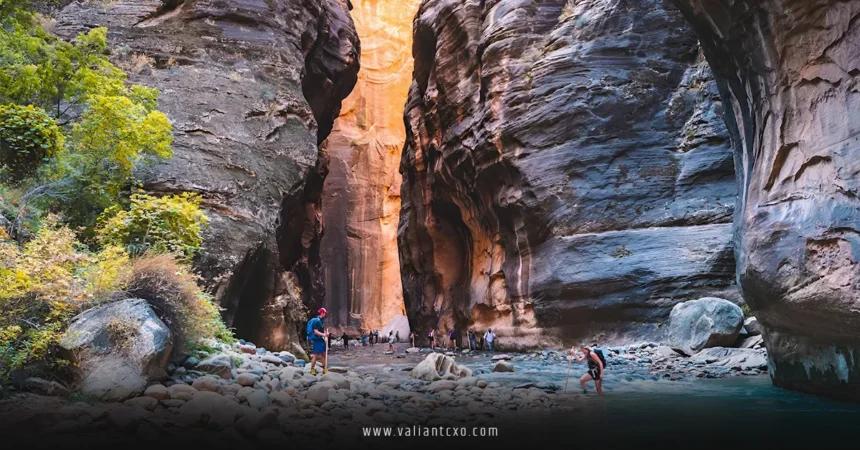Where is Zion National Park and why is it so famous? Nestled in the heart of southern Utah, Zion National Park is a breathtaking natural wonder that draws millions of visitors each year with its towering sandstone cliffs, vibrant canyons, and awe-inspiring trails. Its fame isn’t just about postcard-perfect views; it’s a place where nature’s grandeur meets adventure, history, and a touch of spiritual allure. Whether you’re a hiker, a photographer, or just someone craving a break from the daily grind, Zion’s magic is undeniable. Let’s dive into where this gem is located and unpack the reasons behind its global renown.
Where Exactly is Zion National Park?
Zion National Park sits in southwestern Utah, USA, a region known for its rugged desert landscapes and dramatic geological formations. Spanning roughly 229 square miles, the park is about 160 miles northeast of Las Vegas, Nevada, making it an accessible getaway for city dwellers. The closest major town is Springdale, Utah, right at the park’s southern entrance, offering a cozy base for visitors. If you’re mapping it out, Zion is also about 300 miles south of Salt Lake City and a scenic drive from other iconic parks like Bryce Canyon and the Grand Canyon.
Getting to Zion is half the fun. Picture yourself cruising along Interstate 15, with red rock formations peeking over the horizon like ancient sentinels. The park’s main entrance is accessible via Utah State Route 9, which cuts through Springdale and leads straight to the Zion Canyon Visitor Center. If you’re flying in, Harry Reid International Airport in Las Vegas is your best bet, followed by a 2.5-hour drive that feels like a journey through a painter’s canvas. So, where is Zion National Park and why is it so famous? It’s not just its location in Utah’s desert heartland but the way it captivates anyone who steps foot in its canyons.
The Geological Marvels Behind Zion’s Fame
A Landscape Carved by Time
Why does Zion National Park stand out? Its geology is a story written in stone, sculpted over millions of years by wind, water, and tectonic shifts. The park’s centerpiece, Zion Canyon, was carved by the Virgin River, a humble stream that’s been chiseling away at sandstone for eons. The result? Towering cliffs that soar up to 2,000 feet, painted in hues of red, pink, and cream that shift with the sun’s angle. It’s like nature decided to show off its artistic skills, and the canvas is nothing short of spectacular.
Iconic Formations That Steal the Show
Ever heard of Angels Landing or The Narrows? These aren’t just hiking trails; they’re geological masterpieces that help answer the question, “Where is Zion National Park and why is it so famous?” Angels Landing is a razor-thin ridge with dizzying drop-offs, offering views that make your heart race and your camera beg for mercy. The Narrows, on the other hand, is a slot canyon where you wade through the Virgin River, flanked by walls that seem to touch the sky. These formations aren’t just pretty—they’re bucket-list destinations that draw adventurers from across the globe.
Why is Zion National Park So Famous?
World-Class Hiking Opportunities
Zion’s trails are the stuff of legend, and they’re a massive reason behind the park’s fame. Whether you’re a seasoned trekker or a casual stroller, there’s a path for you. The Emerald Pools trail, for instance, leads to shimmering waterfalls and serene basins, perfect for families or those seeking a gentle hike. For thrill-seekers, Angels Landing is a heart-pounding climb that rewards you with panoramic views that feel like a glimpse of heaven. Where is Zion National Park and why is it so famous? It’s in these trails, where every step feels like a conversation with nature itself.
A Haven for Outdoor Adventures
Beyond hiking, Zion is an adventure playground. Rock climbers flock to its sandstone walls, tackling routes that range from beginner-friendly to expert-only. The park’s canyoneering opportunities, like descending through slot canyons, are a rush unlike any other—think of it as nature’s obstacle course. Photographers, too, find paradise here, with every sunrise and sunset turning the landscape into a kaleidoscope of colors. It’s no wonder Zion’s vistas have starred in countless Instagram feeds and travel blogs.
A Cultural and Historical Gem
Zion’s fame isn’t just about its natural beauty; it’s also steeped in history. The park’s name comes from early Mormon settlers who saw its towering cliffs as a sanctuary, a nod to the biblical “Zion” meaning a place of refuge. Native American tribes, including the Paiute, have called this region home for centuries, leaving behind petroglyphs that whisper stories of the past. Exploring Zion feels like stepping into a history book, where every rock and trail has a tale to tell.
The Unique Ecosystem of Zion
A Biodiversity Hotspot
Zion’s diverse landscape—ranging from desert lowlands to lush riparian zones—creates a haven for wildlife. You might spot bighorn sheep scaling cliffs, peregrine falcons soaring overhead, or even the occasional mountain lion prowling in the shadows. The park’s flora is just as impressive, with cottonwood trees lining the riverbanks and cacti dotting the arid slopes. Where is Zion National Park and why is it so famous? It’s a place where nature’s variety thrives, offering a front-row seat to an ecological symphony.
Seasonal Beauty That Keeps Visitors Coming Back
Zion’s beauty changes with the seasons, each offering a fresh perspective. Spring brings wildflowers that blanket the canyon floor, while summer’s heat intensifies the red rock glow. Fall paints the park in warm golds and oranges, and winter dusts the cliffs with snow, turning Zion into a quiet wonderland. No matter when you visit, the park’s ever-changing face ensures there’s always something new to discover.
Planning Your Visit to Zion National Park
Best Times to Visit
Timing your trip can make or break your Zion experience. Spring (March to May) and fall (September to November) are ideal, with mild weather and fewer crowds. Summer is peak season, bustling with energy but also packed with visitors. Winter offers solitude and stunning snowy vistas, though some trails may be icy. Where is Zion National Park and why is it so famous? It’s a year-round destination that rewards every season with its own unique charm.
Getting Around the Park
Zion’s shuttle system is a game-changer, especially during peak months. Running from March to November, the free shuttle ferries visitors through Zion Canyon, reducing traffic and keeping the park pristine. For a more intimate experience, biking along the Pa’rus Trail or renting an e-bike in Springdale lets you soak in the scenery at your own pace. If you’re driving, be prepared for limited parking and plan to arrive early.
Tips for a Memorable Trip
To make the most of your visit, start early to beat the crowds and heat, especially on popular trails like Angels Landing. Pack plenty of water, sunscreen, and sturdy shoes—Zion’s terrain doesn’t mess around. If you’re tackling The Narrows, rent water shoes and a walking stick from outfitters in Springdale for better traction. And don’t forget your camera; Zion’s views are begging to be captured. For reliable planning resources, check out the National Park Service’s Zion page for up-to-date trail conditions and shuttle schedules.
Why Zion Stands Out Among National Parks
A Spiritual Connection
There’s something almost otherworldly about Zion. Maybe it’s the way the cliffs seem to glow at sunset or the silence that settles in the canyons at dawn. Visitors often describe a sense of peace, like the park is a cathedral carved by nature. Where is Zion National Park and why is it so famous? It’s this intangible magic, a place that feels like it’s speaking to your soul.
A Global Draw for Nature Lovers
Zion isn’t just a U.S. treasure; it’s a global icon. In 2024, the park welcomed over 4.3 million visitors, ranking it among the top national parks in the country. Its proximity to other natural wonders, like Bryce Canyon National Park, makes it a must-visit on any Southwest road trip. Yet, despite its popularity, Zion retains an intimate feel, with trails that let you escape into nature’s embrace.
Conservation and Responsible Tourism
Zion’s beauty comes with a responsibility to protect it. The park’s delicate ecosystem faces challenges from overuse, so sticking to marked trails and packing out trash is crucial. Programs like the Leave No Trace Center offer guidelines to minimize your impact, ensuring Zion stays pristine for future generations. Where is Zion National Park and why is it so famous? It’s a place that reminds us to tread lightly and respect the earth’s wonders.
Conclusion
Where is Zion National Park and why is it so famous? Tucked away in southern Utah, Zion National Park is a masterpiece of nature, history, and adventure. Its soaring cliffs, thrilling trails, and vibrant ecosystem create an experience that lingers long after you leave. From the heart-pounding heights of Angels Landing to the serene beauty of the Emerald Pools, Zion offers something for everyone. Whether you’re chasing adventure, seeking solitude, or simply yearning for beauty, Zion delivers. So, pack your bags, lace up your boots, and discover why this park is a must-see destination. The canyons are calling—will you answer?
FAQs
1. Where is Zion National Park and why is it so famous for hiking?
Zion National Park is in southern Utah, USA, about 160 miles from Las Vegas. Its fame for hiking comes from iconic trails like Angels Landing and The Narrows, offering stunning views and thrilling adventures for all skill levels.
2. What’s the best time to visit Zion National Park?
Spring and fall are ideal for visiting Zion, with mild weather and fewer crowds. Summer is popular but busy, while winter offers snowy beauty and solitude, making it a year-round destination.
3. How do I get to Zion National Park?
Drive from Las Vegas (2.5 hours) or Salt Lake City (4.5 hours) to Springdale, Utah, near the park’s entrance. Fly into Las Vegas and rent a car for a scenic road trip to Zion’s main gate.
4. Why is Zion National Park so famous for photography?
Zion’s dramatic cliffs, vibrant canyons, and ever-changing light make it a photographer’s paradise. Landmarks like The Narrows and sunset views at Canyon Overlook are perfect for capturing nature’s beauty.
5. Are there family-friendly activities in Zion National Park?
Absolutely! Trails like the Riverside Walk and Emerald Pools are easy and kid-friendly, offering stunning views. The park’s shuttle system makes exploring accessible for families visiting Zion.
For More Updates !! : valiantcxo.com


